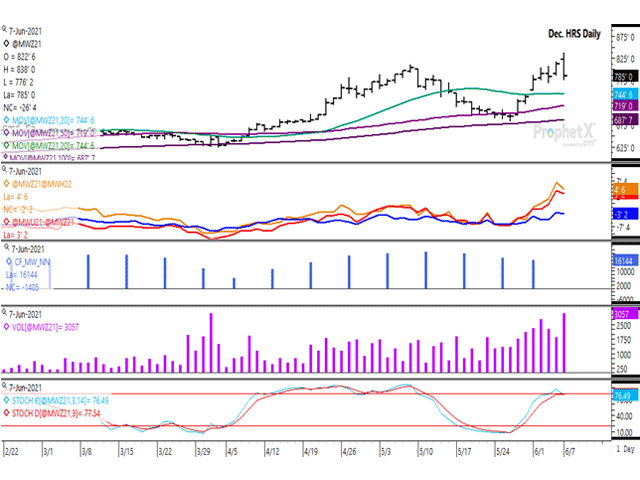Canada Markets
December HRS Reaches a Contract High and Closes Lower
Trading weather markets is not for the faint of heart. While several grain market contracts gapped higher at the June 6 evening open and while weather remains viewed as a bullish feature for major crops in the United States to start the week, several contracts reversed direction to finish lower to end Monday's trade. This included old-crop and new-crop spring wheat.
The December spring wheat shows a bullish gap at the June 6 evening open, reaching a fresh contract high of $8.38/bushel (bu) this session. This move came within 5 cents from testing the $8.43/bu high reached on the December 2017 contract on July 3, 2017, that may act as nearby resistance on the continuous December contract. Following the move, the December contract closed 26 1/2 cents lower at $7.85/bu USD.
As seen on the attached chart, Monday's trade resulted in a bearish outside-bar formed on the daily chart, trading both high and then lower than the June 4 trading range, only to close lower.
Rain in the forecast for most of Canadian Prairies as well as parts of Montana, North and South Dakota and Minnesota during the next seven days have speculators on edge.
P[L1] D[0x0] M[300x250] OOP[F] ADUNIT[] T[]
DTN Contributing Analyst Joel Karlin has reported in this week's Fundamentally Speaking blog that the USDA's initial crop condition rating for spring wheat is the "second-lowest first crop rating ever next to the disastrous year of 1988 when the first rating was 632 and led to a final spring wheat yield an astounding 35% below trend in that horrific drought season."
Despite this initial crop condition rating, released on May 30, noncommercial traders have reduced their bullish net-long position in spring wheat futures for a third straight week, as seen on the blue bars of the histogram seen on the second study. This position was reported at 16,144 contracts net-long as of June 1, the smallest bullish position seen in six weeks.
The lines on the second study show spreads weakening modestly this session, although the September/December futures spread (red line) remains at a bullish inverse of 3 1/4 cents, while the December/March spread (brown line) ended at a 4 1/2 cent inverse, signaling a continued bullish view of new-crop fundamentals that bears watching.
The purple bars on the third study represents daily volume, while the June 7 volume of 3,057 contracts (December contract only) was the largest daily volume seen during the life of the contract as the long liquidation continues.
The lower study shows the stochastic momentum indicators rolling over and crossing, signaling a change of direction on the short-term chart. At the same time, this cross-over is seen below the overbought line of 80, which indicates this is not the most bullish of turns, which are reserved for crossing lines within overbought territory.
Today's late news shows the June 7 Crop Progress report of the U.S. crop condition revised lower to 38% good to excellent, down five percentage points from last week, with North Dakota's condition rating increasing by one percentage point to 32% good to excellent, where approximately 50% of the spring crop is produced.
Cliff Jamieson can be reached at cliff.jamieson@dtn.com
Follow him on Twitter @Cliff Jamieson
(c) Copyright 2021 DTN, LLC. All rights reserved.





Comments
To comment, please Log In or Join our Community .